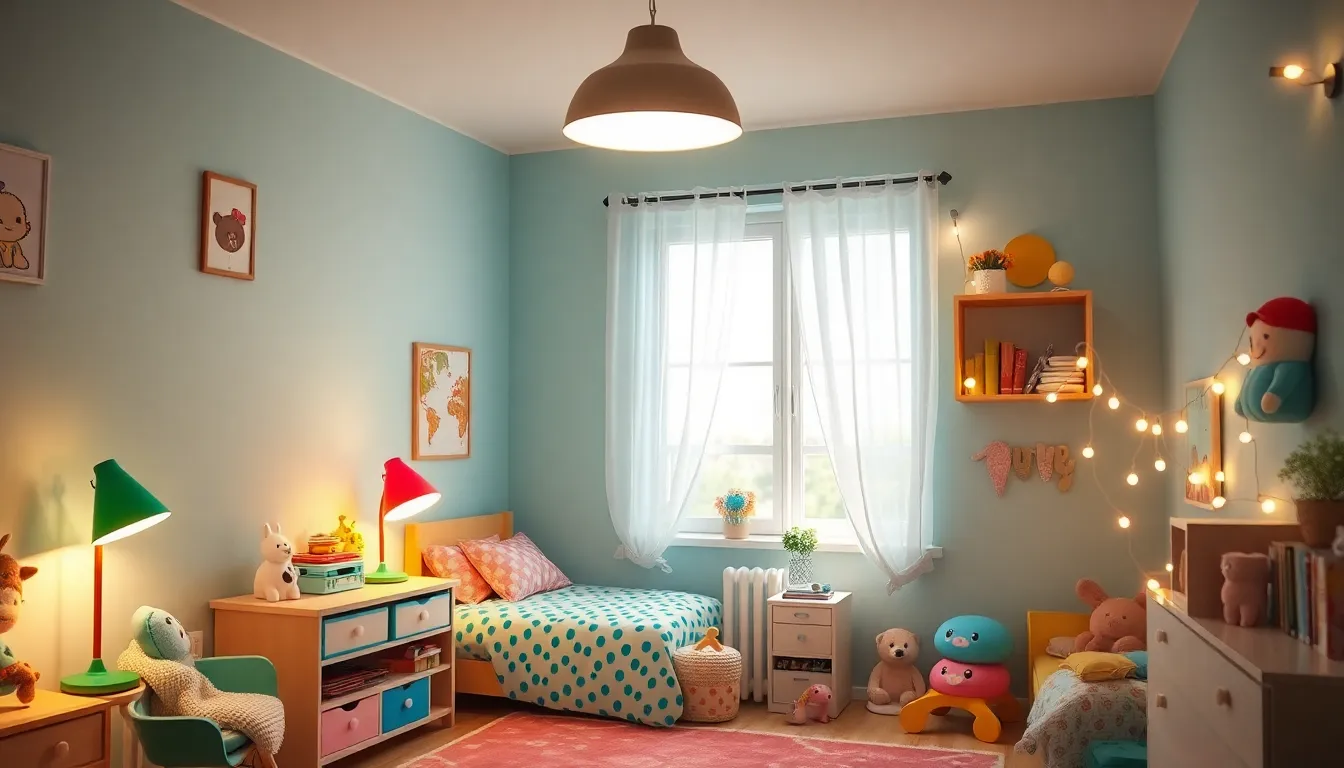When it comes to kids’ rooms, lighting isn’t just about illuminating the space; it’s about creating an atmosphere where imagination can run wild. Picture this: a cozy nook bathed in warm light, where little ones dive into their favorite storybooks or unleash their creativity with arts and crafts. The right lighting can transform a mundane room into a magical kingdom or a spaceship ready for intergalactic adventures.
Table of Contents
ToggleImportance Of Kids Room Lighting
Lighting in a child’s room significantly influences their daily activities and overall well-being. A well-lit space promotes safety, comfort, and creativity. Soft lighting can soothe children during bedtime, establishing a calming environment conducive to relaxation and sleep.
Task lighting, such as desk lamps, supports homework and craft projects, enhancing focus and productivity. With dedicated light sources, children can immerse themselves in learning, fostering a sense of independence.
Natural light plays a vital role as well. Exposure to daylight boosts mood and energy levels, making rooms feel more inviting. It encourages outdoor play and exploration, fundamental for healthy development.
Color temperature affects mood too. Warm light creates a cozy atmosphere, while cooler light energizes and stimulates engagement. By adjusting lighting schemes based on activities, parents can tailor environments for optimal functionality.
Layered lighting, which includes ambient, task, and accent lights, creates depth in the room. Combining these elements allows flexibility in ambiance, permitting transitions from active play to quiet reading.
Incorporating dimmers gives parents control over light intensity. This capability supports various activities, adjusting brightness to suit specific tasks or enhance relaxation.
Ultimately, thoughtful lighting choices enhance the aesthetics and functionality of a child’s room. Prioritizing the right types of lighting cultivates an environment where children can thrive academically, socially, and emotionally. Effective lighting transforms a simple room into a sanctuary of imagination and growth.
Types Of Kids Room Lighting

Choosing the right types of lighting enhances both function and atmosphere in a child’s room. Several categories exist to ensure a well-lit, versatile space.
Ambient Lighting
Ambient lighting serves as the primary light source in a child’s room, creating a warm and inviting atmosphere. Ceiling fixtures or overhead lamps typically provide this general illumination. When selecting ambient lights, consider soft, diffused options to reduce glare. Gentle presence makes the room feel cozy and conducive to relaxation. Energy-efficient LED bulbs can enhance brightness while minimizing energy consumption. Opt for fixtures that align with the room’s decor for a cohesive look.
Task Lighting
Task lighting enables focused light for specific activities, such as reading or studying. Desk lamps or bedside lamps offer direct illumination for homework or bedtime stories. Adjustable features in task lights allow users to position light precisely where needed. Brightness levels can impact concentration, so choose bulbs that provide adequate brightness without being harsh. Consider models with built-in timers to promote consistent routines for both studying and winding down.
Accent Lighting
Accent lighting highlights unique features within the room, adding visual interest and personality. Wall-mounted fixtures, decorative lamps, or string lights can create a playful ambiance. This type of lighting draws attention to artwork or toys, enriching the overall decor. Utilizing colored bulbs or themed fixtures can reinforce a child’s interests. Layering this lighting adds depth, making the room feel dynamic and engaging. Adjustable options allow for creative play with light to fit various moods and activities.
Choosing The Right Lighting For Your Child
Selecting the right lighting for a child’s room involves considering several factors. Key aspects include age considerations and room functionality.
Age Considerations
Lighting needs can vary significantly with age. Infants benefit from soft, warm lighting that creates a calming environment during nighttime feedings. As children grow, they may need brighter task lighting for activities such as homework or arts and crafts. Toddlers enjoy playful designs and colors that stimulate their imagination. Tweens and teens often prefer adjustable lighting to suit studying or relaxing. Understanding these developmental stages helps parents choose the most suitable fixtures.
Room Functionality
Room functionality plays a vital role in determining lighting choices. Different areas within the room serve various purposes. A reading nook requires focused task lighting to support reading and crafting. Play areas benefit from vibrant, ambient lighting that fosters creativity and exploration. Homework stations need brighter, adjustable fixtures to improve focus and productivity. Balancing these needs ensures the room accommodates play, study, and rest, promoting an inviting atmosphere tailored to the child’s activities.
Tips For Efficient Kids Room Lighting
Effective lighting enhances both function and aesthetics in a child’s room. By implementing a few strategies, parents can create a space that encourages creativity and comfort.
Layering Light
Utilizing multiple light sources fosters versatility in the room. Ambient light sets a warm foundation with ceiling fixtures or floor lamps. Task lighting adds focus in specific areas, such as desks or reading nooks. Accent lights can highlight artwork or unique room features, adding personality. This layered approach not only accommodates various activities but also allows for mood changes throughout the day. For example, bright light promotes alertness during homework, while softer light creates a relaxing atmosphere for bedtime stories.
Dimmers And Controls
Incorporating dimmers enhances flexibility in lighting options. Users can easily adjust brightness to suit different activities. For homework, a brighter setting boosts concentration. During playtime, softer light creates a playful vibe. Choosing smart controls allows for remote adjustments, giving parents authority over lighting from anywhere. This control promotes energy efficiency as well reduces glare while ensuring the space remains cozy. Investing in dimmers ultimately offers a balance between functionality and comfort, making room transitions seamless.
Creating the perfect lighting in a child’s room is essential for fostering a nurturing and stimulating environment. By combining ambient, task, and accent lighting, parents can craft a space that adapts to their child’s needs throughout the day. This thoughtful approach not only enhances functionality but also sparks creativity and imagination.
Incorporating dimmers and smart controls allows for seamless transitions between activities, ensuring the room remains cozy and inviting. Prioritizing natural light can further elevate the atmosphere, promoting a sense of well-being. Ultimately, the right lighting transforms a child’s room into a sanctuary that supports growth, learning, and play, setting the stage for a bright future.




